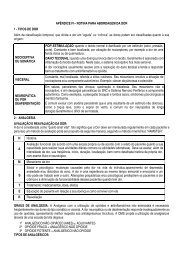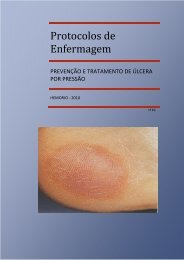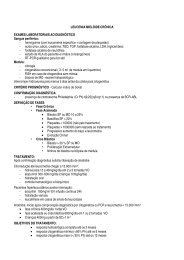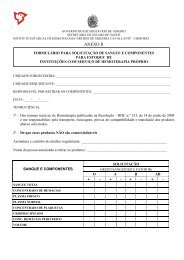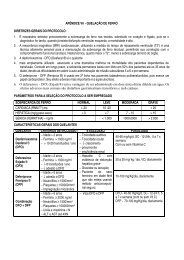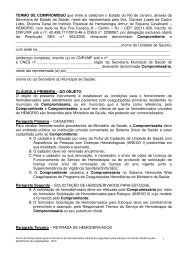Protocols - Hemorio
Protocols - Hemorio
Protocols - Hemorio
You also want an ePaper? Increase the reach of your titles
YUMPU automatically turns print PDFs into web optimized ePapers that Google loves.
HOW TO PRESCRIBE OPIOID:<br />
SPECIAL CARES:<br />
OPIOID AT A NON-ONCOLOGICAL ORIGIN PAIN: Being correctly made, there is no problem to use it.<br />
Subjects with a chronic pain with a non-oncological origin frequently have a long survival and may have<br />
their pain controlled or even cured, and the opioid may be removed.<br />
Subjects that present intense pains of any origin, if they are not treated correctly, need analgesic, because<br />
the pain is an alarm sign, but it also causes serious damages to the body. An episode of intense pain or<br />
multiple episodes of non-treated or incorrectly-treated acute pain, may lead to the development of a<br />
chronic pain.<br />
SPECIAL CARES IN ORDER TO AVOID THE DEPENDENCE:<br />
- the physician must supervise and provide the drug in accordance to the functional and psychological<br />
result<br />
- the physician must control the number of tablets<br />
- only the physician will prescribe a psychotropic<br />
- distrust the subject who looks for some medication before his appointment day, or through a relative or<br />
through another physician, or when the drug ends up before the foreseen time.<br />
- the physician must indicate a physiotherapy, psychotherapy and an occupation therapy for the<br />
improvement of the functional capacity of the subject, with the absence of adhesion of the subject<br />
justifying the discontinuation of the treatment.<br />
DISCONTINUATION OF OPIOID: In order to avoid the physical dependence, the removal must be<br />
gradual, if it is being administered for more than two weeks and in the following form:<br />
After the resolution of what has motivated the pain (for instance, at the algic crisis of Falciform Disease),<br />
the daily total dose will be decreased in 20 - 25% every day, until it reaches the minimum dosage of 5mg<br />
every 4 h, then increasing the interval for every 6 h, every 8 h, every 12 h, until the total removal.<br />
Depending on the time of usage, the removal may be faster or slower, using as a guide the symptoms of<br />
the abstinence syndrome.<br />
MORPHINE AND DISPNEIA: In the cases of breathing distress at rest and tachypnea, by tumoral<br />
invasion, and by other neoplastic causes, unproductive cough, you may use the opioid. If the subject is<br />
already using morphine or codeine, you may increase the dose around 50%, keeping the time interval<br />
characteristic of the drug’s pharmacokinetic, i.e., every 4 h. If the subject does not opioid yet, you may<br />
make an initial dose, for instance, codeine 30mg every 4 h or morphine 5-10mg every 4 h and adjust<br />
according to the response.<br />
202



